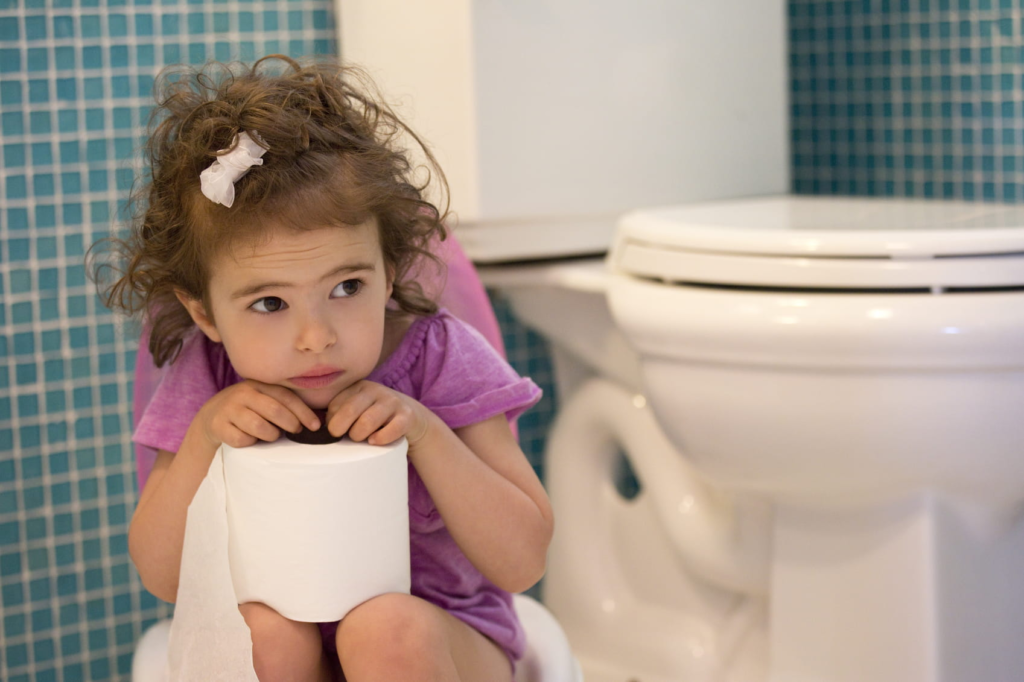Dr. Sanoop Kumar Sherin Sabu M.D., FCPM
Constipation is a common condition in children. It is difficulty or infrequent passage of stools that may cause discomfort or distress. Recognizing the signs and understanding the causes can help manage this issue effectively.
The greatest concern most children face is Stool Withholding. Read this article to understand more about stool withholding and tips to get through.

What is Constipation?
Constipation in children is
- Fewer than three bowel movements per week.
- Passage of hard, dry, or large stools.
- Painful defecation or straining.
- Episodes of fecal incontinence (stool leakage) due to retained stool.
Signs and Symptoms
- Reduced stool frequency.
- Abdominal pain or bloating.
- Hard or pellet-like stools.
- Visible discomfort or crying during defecation.
- Stool withholding behavior, such as crossing legs or clenching buttocks.
Causes of Constipation
- Dietary Factors:
- Low fiber intake.
- Insufficient water or fluid consumption.
- Behavioral Factors:
- Avoidance of defecation due to pain.
- Preference to delay bowel movements during play or school.
- Physiological Factors:
- Slowed colonic transit (sluggish bowel movements).
- Rectal overdistension from chronic stool retention.
- External Triggers:
- Stress, travel, or changes in routine (e.g., starting school or potty training).
- Medical Conditions: Rare causes include:
- Hypothyroidism.
- Hirschsprung disease.
- Spinal cord abnormalities.
- Food intolerances or celiac disease.
Management Strategies
1. Optimize Diet
- Increase Fiber Intake:
- Offer high-fiber foods
- Aim for fiber intake based on the formula: Age (in years) + 5 to 10 grams per day. For example, a 5-year-old should consume 10-15 grams daily.
- Approximated values are
- Infants (0–6 months): 5 grams
- Children (1–3 years): 15 grams
- Children (4–8 years): 25 grams
- Children (9–13 years): 26-30 grams. Females need more fiber
- Adults (14+ years): 25-40 grams .Females need more fiber
Click here to Read more about common food items and fiber content in it.
- Hydration is Key:
- Encourage regular water intake. The ideal daily amount ranges from 1 liter for toddlers to 2 liters for older children, adjusted for activity levels and climate.
- Consider adding a serving of water-rich foods like cucumbers or watermelon to meals.
2. Create a Bathroom Routine
- Timing: Encourage your child to sit on the toilet after meals (especially breakfast) or after drinking 1 glass water in the morning, when the body’s natural gastrocolic reflex is strongest.
- Duration: Have your child sit for 5-10 minutes without distractions. Use a timer or read a short story to make it engaging.
- Position: Ensure proper posture by using a small footstool to elevate the legs, mimicking a squatting position, which helps the rectum relax and empty more efficiently. There are some commercially available models like squatty stools, which will be convenient to use.

3. Address Stool Withholding
Stool withholding is an often underrecognized issue in pediatric care, yet it plays a significant role in the development of constipation. Many children, particularly in early childhood, may withhold stool as a response to pain, fear, or stress, often in the context of potty training or changes in routine. This behavior, if not identified and addressed early, can lead to chronic constipation, fecal impaction, and psychological distress.Understanding and managing stool withholding is essential for improving both physical and emotional outcomes for affected children.

- Watch for signs of withholding (e.g., crossing legs, hiding, or clenching).
- Use positive reinforcement, such as praise or reward charts, for successful toilet use.
- Pain Management: If there is any history of painful defecation, it’s essential to address the root cause of the pain, such as anal fissures or constipation, through appropriate treatment. Ensuring that bowel movements are not painful is key to preventing stool withholding.
- Psychosocial Support: If emotional or environmental stress is contributing to stool withholding, providing a supportive environment is crucial. Acknowledge the child’s fears, offer reassurance, and make toilet training a positive experience without pressure
- Parental Education: Parents should be educated about the importance of a consistent toileting routine, the signs of stool withholding, and how to respond without punishment.
- Collaborative support between healthcare providers and parents is essential for long-term success in addressing stool withholding.

Watch for signs of withholding (e.g., crossing legs, hiding, or clenching).
Positive reinforcement, such as praise or reward charts, for successful toilet use.
4. Promote Physical Activity
- Encourage daily play and movement, as physical activity improves intestinal motility. Activities like running, jumping, and cycling can be particularly beneficial.
- Limit sedentary behaviors, including excessive screen time.
5. Minimize Stress and Anxiety
- Avoid pressuring your child to use the toilet, as this may worsen anxiety.
- Normalize bathroom talk and provide privacy during toilet use to make them feel comfortable.
- Discuss school bathroom policies with teachers if your child avoids using toilets at school.
Never stress your child. Once he or she enters into the vicious cycle of stool withholding, stressing him will worsen the situation
7. Use Medications When Needed
If you feel that the child is getting anxious and stressful just use the stool softening medicines prescribed by your doctor and follow the above measures. He will become better as he get out of the vicious cycle.
Never Do Digital Evacuation of Stools with Fingers
Foods to Prevent and Relieve Constipation

| Foods to Eat (Prevent Constipation) | Foods to Avoid (Worsen Constipation) |
| Fruits: apples (with skin), papaya, ripe bananas, Prunes, pears, kiwi | Unripe bananas, canned fruits in syrup |
| Vegetables: Spinach, broccoli, carrots, peas, sweet potatoes (with skin) | Fried vegetables, heavily salted pickles |
| Whole Grains: brown rice, Oats, whole-wheat bread, quinoa, barley | White rice, white bread, refined pasta |
| Legumes: Lentils, chickpeas, kidney beans, moong dal | Processed baked beans with high salt or sugar |
| Nuts & Seeds: Flaxseeds, chia seeds, almonds, walnuts | Salted or fried nuts |
| Probiotics: Yogurt with active cultures, buttermilk | Full-fat cheese, excessive dairy |
| Snacks: Popcorn (air-popped), trail mix with dried fruits | Chips, cookies, sugary pastries |
| Drinks: Water, coconut water, fresh fruit smoothies | Sugary drinks, soda, energy drinks |
When to Consult a Doctor
Seek medical advice if:
- Constipation persists beyond two weeks despite dietary and behavioral changes.
- Your child experiences severe abdominal pain
- Blood in stools
- Stool withholding leads to significant distress or accidents.
- There is a failure to thrive, vomiting, or unexplained weight loss.
Stool Frequency in New born
For infants less than 3 months of age, the definition of constipation is not solely based on the number of stools passed, as stooling frequency can vary significantly, especially in breastfed infants. However, a general guideline suggests that constipation in this age group may be defined as:
- Fewer than 3 bowel movements per week.
- Hard, dry stools that are difficult or painful to pass, causing discomfort.

In newborns, particularly those who are exclusively breastfed, it is normal to have less frequent stools (sometimes only once every several days). However, when there is significant straining, discomfort, or hard stools, constipation may be suspected, and further evaluation may be necessary.
It’s important to consider the overall pattern and context:
- Breastfed infants: May pass stools 1–3 times per day or as infrequently as once every few days, as long as the stool is soft and the infant is comfortable. Some kids may pass even one time in 7 days.
- Formula-fed infants: Typically pass stools more frequently (often daily), and a decrease in frequency with signs of hard stools can indicate constipation.
If an infant exhibits significant discomfort, excessive straining, or firm stools, it’s important to consult a pediatrician to rule out underlying causes of constipation.
About the Author

Passionate Physician, Trained as Medical Gastroenterologist & Hepatologist
skssabu@gmail.com


